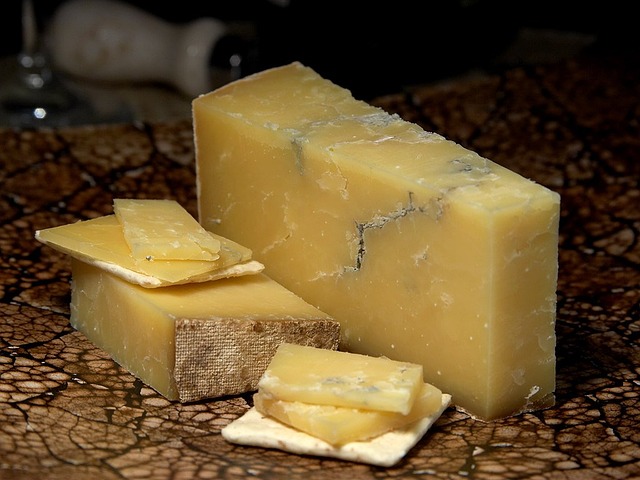How To Make Cheddar Cheese
Once again going back to the article on “How to Make Cheese at Home: A Simple Guide – Save $$” found in the menu to the right, Raw Milk is definitely the preferred choice here. This tutorial in traditional cheddar cheese making is more aligned with the “intermediate” difficulty of cheese making. If you have not made cheese before, I strongly suggest first trying the simpler version found in the link mentioned above. This tutorial requires equipment, some of which can be found in the article “Cheese Making Kit – from $0 up“.

Cheddar cheese is one of the most popular and widely consumed cheeses worldwide, and it’s traditionally made from cow’s milk. This hard, natural cheese can have a crumbly texture if it’s well-aged, while younger cheddar has a smoother consistency. The cheese sharpens in flavor as it matures over a period of 9 to 24 months.
Shaped like a drum, with a 15-inch diameter, Cheddar cheese features a natural rind wrapped in cloth and ranges in color from white to pale yellow. Some varieties of cheddar, like the one I make, may have an added yellow-orange hue.
Cheddar Cheese Recipe
Yield: Approximately 1 kg of cheese
Ingredients:
- 10 liters (10 quarts) of full cream milk, preferably pasteurized/unhomogenized
- 1/8 teaspoon of Mesophilic Culture MO30
- 2.5 ml (½ teaspoon) calcium chloride in ¼ cup water
- 2.5 ml (½ teaspoon) liquid rennet in ¼ cup water
- 12 drops of annatto in ¼ cup water (for color)
- 1½ tablespoons of cheese salt
- Loose weave cheesecloth
- Butter, lard, or coconut oil for banding
Equipment:
- Cheese press
- 165 mm cheese basket with follower
- Cheese drying mat or bamboo mat
- Dairy thermometer
- Stainless steel stirring spoon
- Mini measuring spoons for cultures
Method:
Adding Ingredients
- Sanitize all equipment.
- Warm the milk to 31°C (88°F) while gently stirring. Turn off the heat.
- Sprinkle the culture over the milk and let it rehydrate for 5 minutes. Stir gently in an up-and-down motion without breaking the milk’s surface. Cover and let it rest for 40 minutes at the target temperature.
- Add the annatto solution and mix well.
- Add the calcium chloride solution and mix well.
- Add the rennet solution and mix thoroughly using the same up-and-down motion for 2 minutes. Cover and let it set for 40 minutes.
- Check for a clean break. If necessary, leave for an additional 10 minutes and check again.
Cutting the Curd
- Cut the curds into 1.25 cm (½ inch) cubes.
- Allow the curds to rest for 5 minutes to heal.
- Return to low heat and gradually raise the temperature to 39°C (102°F) while stirring continuously for 45 minutes. Maintain a slow, consistent heating process to avoid bitterness in the aged cheese.
- Once the desired temperature is reached, turn off the heat and let the curds rest for 40 minutes while maintaining the temperature.
Cheddaring, Milling, and Pressing
- Drain curds and whey through a cheesecloth-lined colander.
- Place the curd slab back into the pot for cheddaring, keeping it at 39°C (102°F).
- Cut the slab in half and let the curds stand for 10 minutes.
- Turn each slab over and let stand for another 10 minutes.
- Repeat the turning process every 10 minutes for a total of 45 minutes of cheddaring time.
- Drain the two slabs through a cheesecloth-lined colander, then place them onto a chopping board.
- Cut the curd into 5 by 1.25 cm (2 by ½ inch) fingers.
- Break each finger in half and toss the salt through the curds.
- Line a 165 mm cheese mold with cheesecloth and fill it with curds. Cover the curds with the corners of the cheesecloth, top with a follower, and press at 11 kg (24 lbs) for 1 hour.
- Remove the cheese from the press and unwrap it carefully. Turn the cheese over, rewrap in the cloth, and press at 22 kg (50 lbs) for 12 hours.
Air Drying and Waxing
- Let the cheese air dry on a cheese mat until it’s dry to the touch, typically taking 2-5 days. Rotate the cheese twice a day for even drying.
- Cloth band or wax the cheese, then age it for 3 months for a mild flavor, 6 months for a tasty cheddar, or 12+ months for vintage cheddar. Let the cheese ripen in a cheese fridge set at 10-12ºC (50-54ºF) with 80-85% humidity. Turn weekly to ensure even distribution of fats and flavor.
- At 3 months, the cheese will have a mild flavor. For a sharper taste, age the cheddar for 6 months or longer.
For anyone interested in making Cheddar cheese at home, I recommend using a hard cheese kit that contains most of the necessary ingredients and equipment.
A video which actions the above process can be be found here: